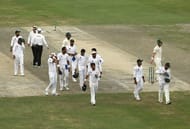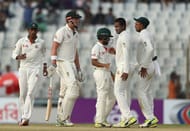The second Test between India and West Indies began today at Hyderabad. In all likeliness, Team India is competing against themselves and would be looking to play more clinical and dominating cricket against a hapless West Indies side that has failed to defeat India in India at a Test match since 1993-94. Such has been the paradigm shift in cricket that the once ‘all-conquering’ Caribbean side is challenged by new blokes in the arena: Bangladesh, Afghanistan, Zimbabwe and Ireland.
On one hand, it’s good for cricket fans to see the game expanding to new horizons but at the same time difficult to witness an old power diminishing gradually. Pundits believe the geographical nearness of Caribbean archipelago to the USA as the reason natives are throwing in the towel when it comes to cricket. It’s not only the lucrative basketball, baseball, American football or soccer that attracts them but also the constant managerial failure by the WICB that comprises of Jamaica, Trinidad & Tobago, St’ Kitts & Nevis, Guyana, Antigua & Barbuda.
Apart from this, the cash-rich IPL and other T20 leagues have attracted them more than anyone else. There was never a dearth of talent in the millennial generation but these factors led them to shift their base into other sports and formats/allegiance (Tests to T20/club before country).
To address this challenge, what ICC needs to do is pit evenly-matched teams against each other; not like a poor goat trying to defend itself against a mighty tiger. Here comes the Indian domestic structure for the longer format that the ICC needs to look into. They should implement the much-talked ‘two-tier system’ in Test cricket as has been prophesied by many ex-cricketers. So let’s take up 5 reasons why the ICC should adopt the Ranji-style pattern in Test cricket.
#1 Two-tier will be more contesting and evenly matched
The two-tier system will consist of two groups; the Elite and the Plate division where the top top-ranked sides will be clubbed in the former division and the bottom five in the latter. And as the policy goes, the top five will play among themselves both in ‘home’ and ‘away’ series. Similarly, the bottom five will also follow the same pattern.
After completion of a certain period, the ranks will be taken into consideration where the fifth-ranked side in the top five will relegate to the Plate division and the sixth-ranked side will elevate to the Elite Division, and the process continues.
Applying this procedure, the bottom five will be propelled to do better and improve their rank to challenge the big boys sitting on top. On the other hand, the top five will be cautious enough not to drop down in their rankings.
Broadcasters will not be at loss

Once the two-tier system will be followed, it will yield more evenly matched contests which will draw a better audience, both in the stadiums and before the television sets/live streaming. The broadcasters will not be incurring any loss as has been the case in most one-sided matches so far where the Test completes within two and a half to three days and most importantly the result is predictable.
Rather, the nail-biting clashes will be imminent and ranks will be taken seriously and fans will be on the edge of their seats.
Gap between top-ranked and lowest-ranked team will improve in long-run

The two-tier system will overall improve the gap between a top-ranked side and a bottom-ranked side. For example, the lowly-ranked side will have that ‘fire in the belly’ to rise and someday match the top-ranked side.
What happens here is, that side needs to defeat, outclass other teams in its fray and by the time it challenges the top rankers, it can at least put up a fight rather than just participate. The best example of a fast-improving side in world cricket is Afghanistan, who particularly has excelled a hell lot in the shorter format of the game.
Over the last decade, it can be Bangladesh.
With new experimentation, cricket will be benefited

Optimistic cricket pundits, fans and Test cricket lovers will give a thumbs up to the two-tier format as it will improve the game as it has been played; as change is imminent and conventional methods have kept on evolving with new experiments like the DRS system, snick-o-meter, hawk eye (ball tracking) method….thanks largely to technology that started with ‘third umpire’ decision.
Just the way ‘pink ball’ D/N Tests are getting acceptance, it is a matter of time that this concept will also gain popularity among the Test playing nations.
And perhaps, the old-order will be preserved better, like The Ashes (as mostly both Australia and England are expected not to drop below top 5) or the India-Pakistan rivalry (where Pakistan will try not to drop below top 5 if at all the arch-rivals agree to play).
Cricketers will take Test cricket more seriously

In all, the two-tier system will have a different impact on cricketers ‘on an individual level’ as each one of them donning the whites will try to give their best, keeping in mind not only the team’s ranking but also their personal achievements and milestones, as most of the greats of the game chose Test cricket as the best format of the game that defines the real character of a cricketer where his skills, temperament, fitness, timing, attitude, tactics are measured to the threshold (particularly by the media and critics).
This will also help Test cricket survive in the fast flourishing world of T20 cricket and the existing mix of Test and T20 format i.e. the ODI format.
To conclude, the ICC's proposal for the inception of ICC World Test Championship in 2019, which is supposed to be the premier championship for Test cricket keeping in mind ICC’s goal of having one pinnacle tournament for all the 3 formats. But personally speaking, this is not possible for ICC to conduct the conventional bilateral pattern of Tests (2 teams at a time) like that in a limited overs mega-tournament. The cricketing calendar, unlike the past, is mostly packed throughout the year and it will be really a tough ask for ICC to trim other proposed tours and programs.
Moreover, players and FICA (Federation of International Cricketers Association) have time and again complained of workload constraints leading to injuries, draining of mental health, and lack of time to rejuvenate with family members.
The proposed World Test Championship has been cancelled twice and chances look bleak for it to start. Rather, the two-tier system, for the meantime will do a world of good to Test cricket and can at least be accommodated within the proposed plans in a calendar year.
Meanwhile, the ICC should continue to encourage the pink-ball D/N Test format which so far has been a success and drawn decent crowds in Adelaide, Dubai, Brisbane, Birmingham, Port Elizabeth, Auckland and Bridgetown.
Brand-new app in a brand-new avatar! Download CricRocket for fast cricket scores, rocket flicks, super notifications and much more! 🚀☄️
